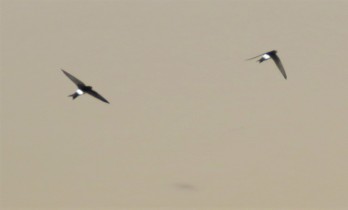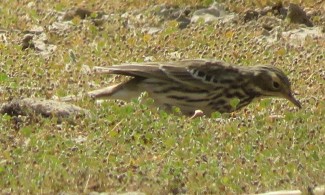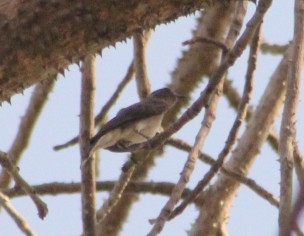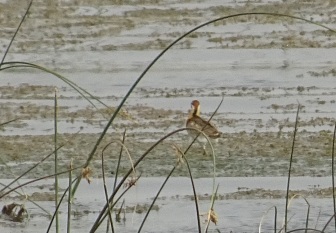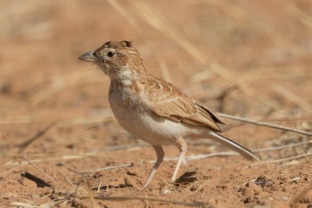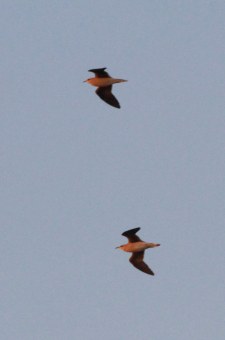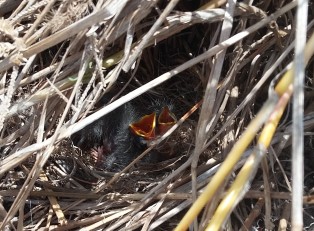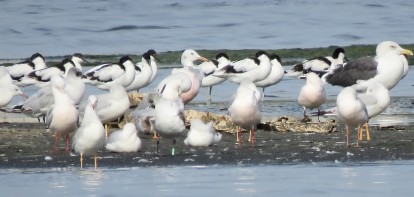Technopole – more gulls, breeding waders & more

It’s been a while since Technopole last featured here, mostly for a lack of birds… With water levels now extremely low – the main pond only has a few shallow patches of water left – and as a result bird numbers are very low. Just a few hundred Black-winged Stilts, and Spur-winged Lapwings, 100-200 Slender-billed Gulls, the odd Audouin’s and a few oversummering Black-headed Gulls, a few lone waders here and there, 6-8 Greater Flamingos and that’s about it. Luckily there’s always something to see at Technopole, and even if overall numbers of migrants are low at the moment, there’s always some of the local species for which it’s now breeding season!
But more about the gulls first.
One of the previous winter’s Mediterranean Gulls remained up to 10 June at least but only allowed for a few poor records shots, rather unusually a 2nd summer (rather than 1st summer) bird. Apparently the first June record for Senegal, of what in the past 10-20 years has become a regular winter visitor in small numbers to the Dakar region. The last Yellow-legged Gull (Goéland leucophée) was seen on 2 May, also a rather late date.
Actually I just realised that I hadn’t shared some of the better pictures of the star bird of the spring here: the 2nd c.y. Laughing Gull, which ended up staying from 25 April until 22 May at least. With the exception of the adult bird this spring (which was seen only twice by two lucky Iberian observers 🙂 on 21-23 April), all previous records were one-day-wonders.
And while we’re at it, here’s the stunning adult Franklin’s Gull in breeding plumage, which unfortunately didn’t linger and was seen just once, on 30 April, at fairly long range hence the hazy pictures:
This bird is from the following day, probably the 2nd summer seen several times between 13 April and 2 May:
Several Black-winged Stilts are still on the nest, but breeding success appears to be low (because water levels are too low, making the nests more vulnerable?). Only a handful of little stiltlets are seen on each visit, and hardly any older juvs. are around. Wondering whether those at Lac Rose may be more successful this year…
A welcome surprise though was a tiny Kittlitz’s Plover chick (Gravelot pâtre), barely a few days old, seen on 10 June. Previous breeding records here were in June 2016 (probable) and July 2012.
Greater Painted-Snipe (Rhynchée peinte) may also be breeding as a pair was seen on 23 June and a male two weeks earlier in the same area (past golf club house on edge of lake near the small baobab!).
And this year there are quite a few Little Bitterns around, quite obviously more than in previous years, with sightings including several singing birds and pairs in at least five locations. I guess the number of territories all over the Grande Niaye de Pikine could easily exceed 10-12 pairs/singing males. Here’s a rather poor picture of a pair seen on our most recent visit, just before it flew off:
Little Grebe (Grèbe castagneux) was once again confirmed to be breeding, though later than in previous years: an adult with a still downy juv. (aged 1-2 weeks?) was on the small pond past the golf course on 10 June, in the same site as in previous years. Previous records in central and northern Senegal were during Dec. – April (read up more about the breeding status of Little Grebe in Senegal & Gambia in this paper that we published in Malimbus last year)
Another nice surprise last Sunday (23/6) was the first Diederik Cuckoo (Coucou didric) of the season in these parts of the country: a singing bird flew high over the pond coming from the Pikine side, then was heard again later on in the tree belt near the football field. Almost as good as hearing the first Common Cuckoo in early April, back “home” in Geneva!
We’re almost there! In the end, there’s been quite a lot to catch up on since early May…
This colour-ringed Gull-billed Tern which I think I’ve mentioned before is indeed from the small colony of Neufelderkoog in northern Germany – the only site where the species breeds north of the Mediterranean region – and as it turns out it’s only the second-ever resighting of one of their birds in Africa. The first was that of a first-winter bird seen in February 2017 in Conakry, Guinea. Our bird ended up staying at least 16 days, from 13 – 28 April. It was ringed on 18 July 2017 by Markus Risch (“WRYY”: white-red/yellow-yellow) and was a late or replacement brood, and the bird was among the latest fledglings of all.
This Common Ringed Plover was around for some time in April / early May, ringed in Norway (details yet to be submitted).
Also on the ringing front, we’re still waiting to hear back for some of the 40-50 Sandwich Tern ring readings Miguel and I managed to make this spring. One of the most recent birds, seen on May 1st, was ringed in June 2017 at Hodbarrow RSPB reserve in Cumbria (UK), and was already spotted on 25/11/17 at Kartong in Gambia (4,720 km, 148 days). While 2nd c.y. birds all stay in Africa during their first summer, third calendar-years such as this one may already migrate back to Europe.
Rounding off the overview with the most recent addition to the Technopole list: African Wattled Lapwing (Vanneau du Sénégal), which surprisingly had not been seen so far, at least not as far as I know – seems like the species actively avoids dense urban areas, since they are regular just outside Dakar but obviously a bit of a vagrant here in town. One was seen flying past, calling a few times, on 10 June.
Species number 239!
Let’s see if we can manage to find 240 in the next few weeks.
The Great Re-Tern

April is Tern month!
From mid-March into May, lots of terns pass through Dakar on their way back home from the wintering grounds further south – some as far as South Africa! – and the first half of April is definitely peak time for many species. When conditions are right, literally thousands of these elegant birds may pass through on a single day, and sites such as Technopole can hold several hundreds of birds at any one time. So much that in the past week, I’ve had the chance to see 12 out of the 14 tern species that are known to occur in Senegal, the only ones missing being Bridled and the rare Sooty Tern.
On Monday 8.4 at Technopole, decent numbers of terns were about, mainly Sandwich Tern (+300, likely quite a bit more) with a supporting cast of the usual Caspian and Gull-billed Terns (the former with several recently emancipated juveniles, likely from the Saloum or Casamance colonies), but also several dozen African Royal Tern, a few Common Terns, at least two Lesser Crested, and as a bonus two fine adult Roseate Terns roosting among their cousins. And as I scanned one of the flocks one last time before returning back home, an adult Whiskered Tern in breeding plumage, already spotted the previous day by Miguel. I managed to read four ringed Sandwich Terns but far more were wearing rings, but were impossible to read.
Yesterday 13.4, we went back to our favourite urban hotspot mainly in order to see if we could read some more of these rings. The main roost is close to the northern shore of the main lagoon, quite close to golf club house, which makes it possible to get close enough to the birds to read most rings. We saw most of the same tern species (except Roseate), with the addition of a fine moulting White-winged Tern and a small flock of Little Terns migrating over our heads. The first colour-ringed bird we saw was actually a Gull-billed Tern, but not the usual Spanish bird (“U83”) ringed in 2009 and seen several times herein the past three winters. This bird was even more interesting, as it was ringed in the only remaining colony in northern Europe, more precisely in the German Wadden Sea. Awaiting details from the ringers, but it’s quite likely that there are very few (if any!) recoveries of these northern birds this far south. It may well be the same bird as one that we saw back in November 2018 at lac Mbeubeusse, though we didn’t manage to properly establish the ring combination at the time.
So, back to our ring readings: all in all, we managed to decipher an impressive 14 Sandwich Tern rings – blue, white, yellow & red! – of birds originating from no less than four countries: Ireland, UK, Netherlands, and one from Italy (to be confirmed). Most of these are chicks that were born in summer 2016 and that logically spent their first two years in the Southern Hemisphere, and are now returning back to their breeding grounds for the first time. In addition, a Black-headed Gull with a blue ring proved to be a French bird ringed as a chick in a colony in the Forez region (west of Lyon) in 2018, while a Spanish Audouin’s Gull was a bird not previously read here. I’ll try to find some time to write up more on our ring recoveries, now that my little database has just over 500 entries!
Others local highlights from these past few days are the Lesser Yellowlegs still at Technopole on 8.4 (but not seen yesterday… maybe it has finally moved on), also a superb breeding plumaged Bar-tailed Godwit, still a few Avocets, plenty of Ruff, Little Stint, Sanderling, Curlew Sandpiper and Dunlin, many of which in full breeding attire. And on 13.4, once again a Franklin’s Gull, but also a rather late Mediterranean Gull and what was probably the regular adult Yellow-legged Gull seen several times since December. Three Spotted Redshanks were also noteworthy as this is not a regular species at Technopole. The Black-winged Stilts are breeding again, and the first two chicks – just a couple of days old – were seen yesterday, with at least two more birds on nests; a family of Moorhen was also a good breeding record.
Full eBird checklist from 13.4 here.
Earlier this week at the Calao was just about as good in terms of tern diversity: again the usual Sandwich Terns which are passing through en masse at the moment, with some LCT’s in the mix, several dozen Common Terns and the odd Roseate Tern hurriedly yet graciously flying past the seawatch spot, and of course more Royal Terns en route to Langue de Barbarie or Mauritanian breeding sites, a lone Caspian Tern, and this time round an even less expected White-winged Tern (and just two Black Terns). Oh and also the first Arctic Tern of the season! The first birds in spring are typically seen at the end of March or first half of April; earliest dates (2015-2018) are 16.3.18 and 25.3.16. The numbers of migrating terns were really impressive here on Saturday 6.4: a rough estimate puts the number of Sandwich and Common Terns passing through at 500 and 1200, respectively, in just two hours.
At Ngor, regular morning sessions have yielded the usual Pomarine and Arctic Skuas, Northern Gannets, as well as a handful of Cape Verde Shearwaters feeding offshore on most days. Sooty Shearwaters passed through in good numbers on 6.4, while last Friday (12.4) was best for Sabine’s Gull: 73 birds in just one hour, so far my best spring count. Also several Long-tailed Skuas and the other day a South Polar or (more likely) a Great Skua was present, a rare spring sighting. All checklists for the recent Calao counts can be found on this eBird page.
27/1/19, journée folle au Technopole

Il y a des jours comme ça!
Après une sortie déjà bien mémorable en compagnie de Simon le 24/1, lorsque nous observons entre autres des Canards chipeaux et un siffleur – tous deux des nouvelles espèces pour le site que Simon avait trouvées la veille – puis d’un Bécasseau de Temminck, Miguel et moi avons pris le temps de bien fouiller notre local patch dimanche dernier. Arrivés à l’aube sur les lieux, nous sommes repartis cinq heures plus tard avec pas moins de 111 espèces au compteur. Pas mal du tout, si l’on considère qu’une visite typique en hiver apporte généralement 70 à 80 espèces. De plus, la journée a été exceptionnelle aussi bien point de vue quantité – il devait y avoir facilement 4’000 oiseaux au Technopole ce jour-là – qu’en termes de qualité, avec plusieurs oiseaux rares et tout à fait inattendus.
Voici donc, in order of appearance, une sélection d’espèces rencontrées:
- Tourtelette d’Abyssinie (Black-billed Wood Dove): un juv. dans le coin nord-est du site était une petite surprise, cet oiseau n’ayant apparemment jamais encore été signalé auparavant au Technopole. En même temps, une Tourterelle vineuse (Vinaceous Dove) chantait dans le cordon boisé juste derrière: espèce numéro 233 pour le site!
- Hibou des marais (Short-eared Owl): on pensait qu’ils ne reviendraient pas un deuxième hiver de suite, mais les revoilà! Au moins deux de ces hiboux qui nous avaient gracié de leur présence l’hiver dernier, alors qu’un afflux important se déroulait en Afrique occidentale, étaient de nouveau présents sur leur dortoir favori dans un groupe d’acacias. Ils y avaient déjà été répéres fin décembre par deux observateurs, donc tout indique qu’ils resteront encore jusqu’à fin mars ou début avril avant de repartir pour nicher en Europe.
- Bécasseau de Temminck (Temminck’s Stint): déjà vu le 24/1, il ne nous a pas fallu beaucoup de temps pour le retrouver dans le même secteur, se nourrissant en compagnie d’autre bécasseaux. Du coup, nous avons pu observer en cette seule matinée tous les Calidris réguliers du pays: Bécasseau maubèche, cocorli, variable, minute et sanderling – pas mal, non? De plus, ce n’est apparemment que la deuxième obs du Temminck au Technopole, la précédente datant de mai 2015. A peine visibles sur la photo, les pattes jaunâtres en combinaison avec le dessus et la poitrine bruns uniformes sont typiques de ce petit bécasseau, trop souvent confondu avec le Minute. Il est ici tout à fait en marge de son aire de répartition régulière, étant bien plus commun en Afrique de l’Est (au Sénégal, il semble hiverner en petit nombre dans le bas-delta notamment).
- Chevalier à pattes jaunes (Lesser Yellowlegs): alors que je cherchais à mieux observer un pluvier posé parmi les nombreux Grand Gravelots (c’était un argenté…) je vois un chevalier suspect tout près de la piste, se nourrissant activement dans la vase: bec sombre assez court à base légèrement jaune, dessus gris-brun uni, dessous blanc, croupion blanc, et surtout: des pattes jaunes flashant… encore un Tringa flavipes! Serait-ce le même que celui vu l’hiver dernier en février, peut-être même l’oiseau déjà vu en août 2015 et janvier 2016, voire également à Yene en novembre 2017?? En tout cas cette régularité d’observations est intriguante. Comme pour les bécasseaux, nous avons pu observer ce jour tous les chevaliers réguliers au Sénégal, car en plus des habituels des lieux il y avait également deux ou trois Chevaliers arlequins, peu communs ici (Spotted Redshank). En plus de quelques photos relativement nettes pour une fois, on a même réussi à faire un enregistrement de son cri, à écouter ici.
- Goéland de la Baltique (Baltic Gull): probablement la plus grosse surprise du jour, on a été bien étonnés de voir un adulte on ne peut plus typique de cette sous-espèce nominale du Goéland brun: en comparaison directe avec ce dernier, notre oiseau s’en distinguait nettement par sa taille plus petite (sans doute s’agissait-il d’une femelle), son manteau très sombre, presque noir même, et surtout une projection primaire importante lui conférant un aspect bien plus élégant et plus allongé (un peu comme un Pluvier bronzé comparé au Pluvier argenté!). En vol, les ailes longues et plutôt étroites, avec très peu de blanc au bout des primaires externes, étaient frappantes. Malheureusement après un envol général l’oiseau n’a pas été revu, donc pas de photos à l’appui… Notre première obs au Sénégal, ce taxon est néanmoins connu pour hiverner en effectifs très modestes sur les côtes d’Afrique de l’Ouest (quelques individus? pas sûr même que ce soit un visiteur annuel). Sa présence ici, loin de ses quartiers d’hiver réguliers en Afrique de l’Est et l’ocean indien, a été confirmée grace à quelques lectures de bagues notamment en Gambie. Egalement présent dans le tas de centaines de goélands, au moins un Goéland leucophée (Yellow-legged Gull) de 1er hiver, un individu au manteau très clair.
- Mouette mélanocéphale (Mediterranean Gull): une dizaine d’oiseaux au moins, soit un peu plus que d’habitude. Comme toujours, l’essentiel des effectifs hivernants est composé d’oiseaux de premier hiver. Pas vu d’oiseaux bagués cette fois-ci, mais on vient de me signaler – merci Renaud – que “RV2L” vu l’hiver dernier a été observé il y a tout juste quelques jours au Portugal.
- Canard chipeau (Gadwall): les trois individus trouvés par Simon le 23/1 étaient toujours présents, bien que pas forcément faciles à répérer dans le tas d’anatidés, bien plus compact que quelques jours plus tôt: avec près de 400 Souchets et autant de Sarcelles d’été, cela fait du monde à fouiller… Il s’agit a priori de la première donnée sur la péninsule du Cap-Vert de cet hivernant rare au Sénégal, dont les quelques observations proviennent sauf erreur toutes du bas-delta. On n’a pas vu la femelle de Canard siffleur (Wigeon) cette fois alors qu’elle était assez bien visible les 23-24/1; là aussi il s’agirait d’une première pour le Technopole. Cela fait donc pas moins de 4 ajouts à la liste, et cela en moins d’une semaine.
- Mouette de Franklin (Franklin’s Gull): encore une obs de ce laridé néarctique! C’est presque devenu banal ici… Un peu loin comme souvent, au repos dans un groupe de Goélands railleurs et Mouette rieuses – bien nombreuses ce jour – j’ai tout de même fait une photo-preuve où l’oiseau, au manteau gris sombre et au capuchon déjà en grande partie noir, est tout juste reconnaissable au milieu du groupe. Entre la photo du Temminck et celle-ci, je ne sais pas laquelle gagnera au concours de la photo la plus pourrie du jour…
Pour le reste, voir notre checklist eBird (merci Miguel!)
Une fois de plus, le Technopole confirme sa position de haut-lieu de l’ornithologie sénégalaise, et de hotspot urbain tout à fait exceptionnel. A voir ce que nous apporteront les prochaines visites!
Year in review: 2018
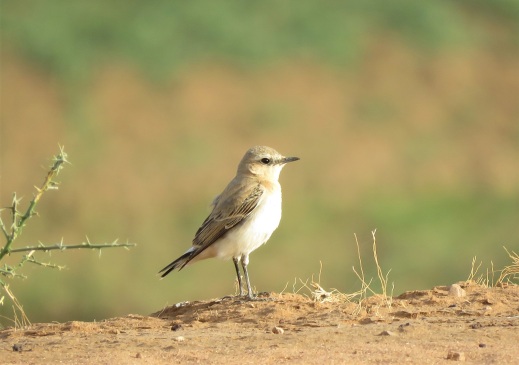
Just like last year we’re bringing our readers a summary of the past year, reviewing some of the ornithological highlights and discoveries made in Senegal, and recycling some of the pictures and posts that appeared on this website during the past 12 months.
2018 certainly has been a busy year!
We’ll start with the best of all: the discovery of what appears to be an isolated (?) population of Horus Swifts (Martinet horus), some 3,000 km from the nearest known breeding sites and more than 1,600 km from the nearest observations of the species (in northern Ghana). This is probably one of the least expected range extensions uncovered in West Africa in recent years, and something we’re of course quite excited (and rather proud!) of. We found these birds during an epic 4-day trip up north together with Frédéric Bacuez and visiting birder Filip Verroens from Belgium, in early January. Needless to say, the year started off with a bang! Read up the full story here and on Frédéric’s Ornithondar blog (in French). A few of these neat swifts were seen again in February by Frédéric and Daniel Nussbaumer, then in October by Vieux Ngom and myself when some 50 birds were present, again showing signs of local breeding and confirming that these birds are most likely residents here, and just last week a group of visiting American birders saw about 25 birds at Gamadji Sare.
Just a few days earlier, in fact on the first day of the year, we’d already found another species new to Senegal: a Meadow Pipit (Pipit farlouse) at the Yene-Tode lagoon just south of Dakar. This find was a bit more controversial – but probably more expected than those swifts! – in the sense that the pipit shows a fairly unusual plumage for Meadow Pipit and certain characters fit Red-throated Pipit better. However, the unstreaked rump and especially the diagnostic call, which was heard loud & clear several times at close range (but unfortunately not sound-recorded), safely rule out Red-throated Pipit, several of which were present in the area at the same time. Full story, description and many pictures here.
Continuing on the same theme, this past year saw the addition of two more species to the Senegal list: Brown-backed Honeybird – which had already been reported from Wassadou in 2015 but was not documented – and Turati’s Boubou. The former was found by Gabriel Caucanas and friends first at Dindefelo, then at Wassadou and later in the Niokolo-Koba NP (more info here), the latter by resident Casamance birder Bruno Bargain back in October. Both were more or less to be expected and back in July we’d actually predicted that the boubou would be found in Casamance some time soon, given that it is known to occur just across the border in Guinea-Bissau. We’ll write up more about this species in due course, and I hope to soon visit the Ziguinchor area again and see (and record) this little-known species – stay tuned!
With no less than four new species, 2018 definitely boosted the national list which now stands at a respectable 678 species; more on this in a blog piece we wrote on the topic of the national list, which contains a link to a handy spreadsheet with all species seen in Senegal, with English, French and scientific names.
Of course there were also the usual lot of vagrants, mostly Nearctic waders in the Dakar region and especially at Technopole, pretty much as usual!
- Common Shelduck (Tadorne de Belon): eight in the Djoudj NP on 17/1 were likely the same group as seen in the Diawling just across the border in Mauritania on 30/12, while one at Technopole on 18-19/2/18 confirmed the small influx that occurred during the ‘17/’18 winter: 8th and 9th records!
- Red-footed Booby (Fou à pieds rouges): one was photographed at Iles de la Madeleine on 26/1 but was only identified later on, while at Ngor up to two adults were seen on several occasions in spring (17/5-22/5, and again on 11 and 22/6) and one was seen twice in autumn (13 & 15/11). These are the 2nd to 4th records for this tropical seabird, which was seen for the first time in October 2016 only.
- Cinereous (=Black) Vulture (Vautour moine): an imm. west of Fatick on 30/1 and one (different bird) on 26/2 near Sagata, east of Kebemer. These observations coincide with the first records for The Gambia (Feb. ‘18) and Mauritania (Dec. ‘17). We also reported the first record of the species, which had not yet been published so far – more details on the status of this increasing Palearctic vagrant in this piece.
- American Golden Plover (Pluvier bronzé): one at Technopole on 8 April, followed by two autumn birds, at lac Mbeubeusse on 3/11 and barely a week later a different bird at Pointe Sarene near Nianing on 9-10/11. Read more on this species in Senegal here.
- European Golden Plover (Pluvier doré): one at Île de Saloulou (Basse Casamance) on 3/1.
- Lesser Yellowlegs (Chevalier à pattes jaunes): the 8th record was one at Technopole seen by a visiting birder on 8/2 and relocated on 19/2
- Baird’s Sandpiper (Bécasseau de Baird): the second for Senegal (and first properly documented) was found at Technopole on 25/3 and seen again on 8/4.
- Buff-breasted Sandpiper (Bécasseau rousset): two birds stayed for a remarkably long time at Technopole, being present from 13/1 (at least one) up to 19/2 at least, then again on 25/3 though this was probably a new bird given that regular visits earlier in the month failed to relocate the two long-stayers; these are the 8th and 9th records.
- Red-necked Phalarope: (Phalarope à bec étroit): one at Djoudj on 27/2 is the 6th record at least, though it’s quite possible that the species is a more regular visitor than the handful of confirmed records suggest.
- Franklin’s Gull (Mouette de Franklin): one was seen five times between 20/5 and 20/9 at Technopole; we summarised the status and trends of the species in this post.
As usual there are also several African vagrants to be reported, such as Lesser Jacana (Jacana nain) seen on 31/1 and 17/2 (three birds!) at Médina Afia near Manda, Kolda dept., and at Ross Bethio on 15/7 – there are only a handful of previous records, including just one in the north (more on status of this species in this post by Ornithondar). A Pharaoh (= Desert) Eagle-Owl (Grand-duc ascalaphe) filmed at Richard Toll on 20/1 was the third record. Six Senegal Lapwings were found at Kamobeul (Ziguinchor) on 30/9 – apparently the first record in 38 years! Three other species with uncertain status in Senegal – true vagrants or scarce but regular visitors? – were seen in the Niokolo-Koba area: Mottled Swift in February and June; a Forbes’s Plover in June and an Ayres’s Hawk-Eagle on 6/3 (Martinet marbré, Pluvier de Forbes et Aigle d’Ayres) .
A special mention goes to the Kordofan Lark (Alouette du Kordofan) that was photographed at Richard Toll on 1/3 by a group of lucky Belgian birders; this is the first record in several years, and the first pictures to be made available online for this species, prompting us to discuss ID criteria and status in Senegal of this enigmatic Sahel special, see this blog piece co-authored with Simon Cavaillès – by far the most read article on the blog, with more than 500 views since its publication in April.
Several winter visitors were seen in higher than usual numbers or reached areas further south than their usual wintering grounds, such as Short-eared Owl (Hibou des marais; seen in six locations during January-March including a group wintering at Technopole, following the influx in Nov.-Dec.). Other scarce winter visitors included a Little Gull (Mouette pygmée) at Ngor on 12/1, while a group of five Cream-coloured Coursers (Courvite isabelle) near Maleme Hodar (Kaffrine) on 1/3 were possibly the southernmost record ever. Other examples include a Spectacled Warbler (Fauvette à lunettes) near Kaolack on 3/3, a “Desert” Grey Shrike (now surprisingly lumped again with Great rather than Southern Grey Shrike; Pie-grièche grise) in the Boundou reserve on 15/3, and five House Buntings (Bruant du Sahara) at Richard Toll on 1/3.
As usual, a few birds were spotted outside of their regular range in the country: several Pallid Herons on the Cap-Vert peninsula; an African Hawk-Eagle that gave us a bit of an ID challenge at Popenguine (3/11); a Greyish Eagle-Owl photographed at Trois-Marigots on 10/1 (only a couple of previous records from N Senegal, see story on Ornithondar); a Grey Phalarope on 25/2 at Médina Afia (a rare inland record!); a singing Klaas’s Cuckoo near Dagana on 6/10; a Broad-billed Roller at Bango (Saint-Louis) on 31/8; Grey-rumped Swallow at Technopole (7/7); an early Lesser Whitethroat at lake Tanma on 25/9; a Cricket Warbler near Gueuol (north of Kébémer) on 21/11 (Aigle fascié, Grand-duc du Sahel, Phalarope à bec large, Coucou de Klaas, Rolle violet, Hirondelle à croupion gris, Fauvette babillarde, Prinia à front écailleux). In the Djoudj, a Brown Snake-Eagle was reported on 5/12. Familiar Chat and Green Turaco were reported from the Niokolo-Koba NP for the first time, where further observations of Mali Firefinch were made (Traquet familier, Turaco vert, Amarante du Koulikoro). Several species were found for the first time in Casamance, including Glossy Ibis, Singing Bushlark, Plain Martin, Great Reed Warbler – details will follow shortly on this website (Ibis falcinelle, Alouette chanteuse, Hirondelle paludicole, Rousserolle turdoïde). Away from the better known wintering grounds in the north of the country, an Iberian Chiffchaff (Pouillot ibérique) was singing at Wassadou on 25/2, and the Technopole bird found on 31/12/17 continued its presence until 7/1 at least.
New breeding records include what appears to be the first confirmed breeding for the Dakar region of Little Tern in June at Lac Rose with at least 14 nests; in the same location we found a nest of Plain-backed Pipit, while a Quailfinch at lac Mbeubeusse on 18/11 suggests that the species may be breeding in the niayes region (Sterne naine, Pipit à dos uni, Astrild-caille). Successful breeding of White-backed Night-Herons (Bihoreau à dos blanc) was confirmed in two locations in Casamance and breeding is also likely along the Gambia river at Wassadou where Pel’s Fishing Owl (Chouette-pêcheuse de Pel) must also have bred. Black-winged Stilts (Echasse blanche) bred once again at Technopole where low water levels created decent conditions in April-June. And a nice breeding record was that of a female Standard-winged Nightjar found incubating two eggs at Pointe Sarène on 4/8 (Engoulevent à balanciers).
A few unseasonal visitors were noted, e.g. early Marbled Ducks and a Black-necked Grebe near Djoudj on Oct. 6th, Western Olivaceous and Melodious Warblers as well as a Woodchat Shrike and even two European Bee-eaters in June; an adult Sabine’s Gull at Ngor on 30/7 (first July record it seems?), and summer Yellow-legged Gulls at Lac Rose (Sarcelle marbrée, Grèbe à cou noir, Hypolaïs obscure et polyglotte, Pie-grièche à tête rousse, Guêpier d’Europe, Mouette de Sabine, Goéland leucophée). Up north, a White-throated Bee-eater and a Pygmy Sunbird were photographed in January near Saint-Louis (Guêpier à gorge blanche, Souïmanga pygmée).
We also continued our seabird migration monitoring efforts during 2018, both in spring and in autumn. Spring migration was summarised in two posts (covering April and May) but the autumn totals are yet to be published. Highlights included decent numbers of Long-tailed Skua (500!) and Grey Phalaropes (1,256!) seen in August when fairly strong north-westerlies created ideal conditions to see these highly pelagic migrants from the coast; both species saw new day records for West Africa it seems. Other good ones included at least 19 Barolo/Boyd’s Shearwaters in Aug.-Sept., a Sooty Tern on 17/9 and several Bridled Terns, while Great Shearwaters passed through in modest numbers around mid-November (Puffin de Barolo/Macaronésie, Sterne fuligineuse, Sterne bridée, Puffin majeur). A pelagic trip on October 1st yielded reasonable numbers of Wilson’s Storm-Petrels (Océanite de Wilson), some shearwaters and skuas, but no rarities this time round. A visiting birder was lucky to see a White-faced Storm Petrel on 3/12 at Iles de la Madeleine, while an observation of Band-rumped Storm Petrel was reported far offshore off Saint-Louis on 25/9 (Océanites frégate et de Castro).
On the ring recovery front, we managed to read some 100 colour rings, mainly of Audouin’s and Slender-billed Gulls (41 & 19, resp.) but also several Greater Flamingos from Spain, a Common Ringed Plover from Portugal, and the first mentions of Avocet in our database (two birds from Spain) as well as a French Mediterranean Gull (“RV2L”) which appears to be the first recovery of this species from Senegal (Goélands d’Audouin et railleur, Flamant rose, Grand Gravelot, Avocette, Mouette mélanocéphale). I now have some 420 ring recoveries in my little database: maybe this year I’ll find time to write up some of the key findings.
A few blog posts on birding sites and other topics were published in 2018, namely the following:
- Senegal as a destination for birders, written up by Paul Robinson following his visit to the UK Bird Fair in 2017
- Blog posts on the birds of Dindefelo and Wassadou following visits to these two major birding hotspots in the south-east of the country
- The Casamance Bird Atlas by the association APALIS
- Birding the Niokolo-Koba: guest blog by John Rose and Dimitri Dagone
- The formal protection of Technopole back in October was of course a major event
- A xeno-canto audio guide to the birds of Senegal
- Last but certainly not least, the last blog piece of the year covered the description of a new species of Square-tailed Drongo
We’ve also been pretty active writing up more formal pieces on birds in Senegal, with several articles published in 2018. This post is actually getting a bit too long so I’ll write about these recent publications in a forthcoming article. For now, go out birding!
Finally, thanks to all our readers for their support and encouragement throughout the year, which has seen a further increase in number of page views (almost 25,000) and website visitors. Oh and do let me know if I forgot anything in the above review, which is just an informal overview – nothing official here!

























